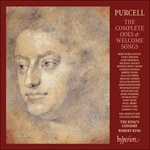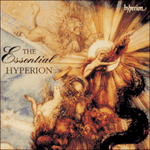
Welcome to Hyperion Records, a British classical label devoted to presenting high-quality recordings of music of all styles and from all periods from the twelfth century to the twenty-first.
Hyperion offers both CDs, and downloads in a number of formats. The site is also available in several languages.
Please use the dropdown buttons to set your preferred options, or use the checkbox to accept the defaults.

‘The Duke of Gloucester’s Birthday Ode’ shows so much that is wonderful in Purcell’s writing: the Overture contains a marvellously rich slow section before the canzona returns, and the solo movements all feature music of the highest order. ‘A Prince of glorious race descended’ in particular demonstrates one of Purcell’s familiar techniques, and one that he used to great effect in so many of his Odes. The movement begins with a ground bass and solo voice, and then, at the mid-point, is transformed into a ravishing four-part string ritornello. The last movement too is a compositional tour de force: Purcell’s extraordinary Chaconne alternates and mixes voices and instruments in a wonderful variety of textures and rhythms.
from notes by Robert King © 2010
«L’Ode pour l’anniversaire du duc de Gloucester» montre tout le merveilleux de l’écriture purcellienne: l’ouverture renferme une section lente, d’une richesse sublime, avant le retour de la canzone, et les mouvements solo présentent tous une musique de la plus haute volée. «A Prince of glorious race descended», surtout, fait la démonstration d’une technique chère à Purcell et marquant, avec beaucoup d’effet, nombre de ses Odes. Le mouvement s’ouvre sur un ground bass et une voix solo avant de se muer, à mi-chemin, en un ravissant ritornello de cordes à quatre parties. Le dernier mouvement est, lui aussi, un tour de force compositionnel: son extraordinaire Chaconne alterne et mélange voix et instruments en une splendide variété de textures et de rythmes.
extrait des notes rédigées par Robert King © 2010
Français: Hypérion
Die Geburtstagsode für den Herzog von Gloucester weist besonders viele interessante Stilmittel Purcells auf. In der Ouvertüre findet sich ein wunderschöner, reichhaltiger langsamer Teil, bevor die Canzona zurückkehrt, und die Solosätze sind alle erstklassig. Besonders in „A Prince of glorious race descended“ kann man eine von Purcell gern verwendete Technik beobachten, die er in vielen seiner Oden wirkungsvoll einsetzt. Der Satz beginnt mit einem Basso ostinato und einer Solostimme, was in der Mitte in ein herrliches vierstimmiges Streicher-Ritornell übergeht. Der letzte Satz ist ebenfalls eine kompositorische Meisterleistung: in seiner außergewöhnlichen Chaconne kombiniert und alterniert Purcell Stimmen und Instrumente und bewirkt so eine wunderschöne Vielfalt an Texturen und Rhythmen.
aus dem Begleittext von Robert King © 2010
Deutsch: Viola Scheffel
 Purcell: The Complete Odes & Welcome Songs Purcell: The Complete Odes & Welcome Songs‘A treasure house of shamefully neglected music. Over nine hours of wonderful invention … this major recording achievement must be an irresistibl ... ‘By any yardstick these are life-enhancing works’ (CDReview)» More |
 The Essential Hyperion, Vol. 1 The Essential Hyperion, Vol. 1'You'll be discovering what a superb label Hyperion is' (The Modern Dance)» More |

